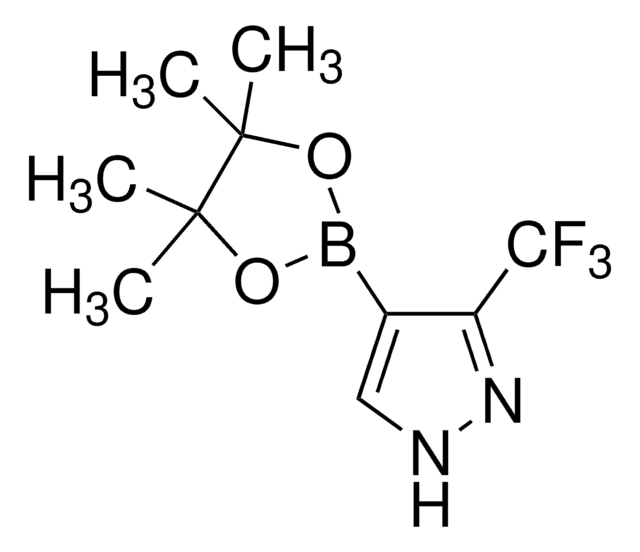803200
DTSSP (3,3′-dithiobis(sulfosuccinimidyl propionate))
Synonyme(s) :
DTSSP, bis(sulfosuccinimidyl) 3,3′-dithiobis(propionate)
About This Item
Produits recommandés
Pureté
≥80%
Niveau de qualité
Forme
powder
Poids mol.
608.51
Pertinence de la réaction
reagent type: cross-linking reagent
Conditions de stockage
desiccated
Solubilité
soluble (>6mg/ml in water)
Conditions d'expédition
ambient
Température de stockage
2-8°C
Chaîne SMILES
O=C(CC1S(=O)([O-])=O)N(OC(CCSSCCC(ON2C(CC(S(=O)([O-])=O)C2=O)=O)=O)=O)C1=O.[Na+].[Na+]
InChI
1S/C14H16N2O14S4.2Na/c17-9-5-7(33(23,24)25)13(21)15(9)29-11(19)1-3-31-32-4-2-12(20)30-16-10(18)6-8(14(16)22)34(26,27)28;;/h7-8H,1-6H2,(H,23,24,25)(H,26,27,28);;/q;2*+1/p-2
Clé InChI
XRWWBWZHHSXBNC-UHFFFAOYSA-L
Description générale
Application
- Enhancing Ocular Antisense Oligonucleotide Delivery: Utilizing Cowpea Chlorotic Mottle Virus-like particles, this study incorporates DTSSP for the enhancement of antisense oligonucleotide delivery targeting posterior segment ocular diseases, demonstrating a novel approach in biocompatible drug delivery systems (Pretto et al., 2021).
- Regulation of Integrin-Tetraspanin Interactions: DTSSP is utilized to stabilize interactions between integrins and the tetraspanin CD9, providing critical insights into cell adhesion and signaling mechanisms, relevant to cancer and other pathologies (Torres-Gómez et al., 2021).
- Gene Delivery Platform Development: A study on adeno-associated viral vectors employs DTSSP for cross-linking to tune cellular tropisms and enhance gene delivery, showing potential for targeted gene therapy applications (Yoo et al., 2020).
- Protein Interactor Identification: DTSSP is instrumental in identifying interactors of the Arabidopsis thaliana Plant Natriuretic Peptide (AtPNP-A) using mass spectrometry, aiding in the understanding of plant signaling pathways (Turek et al., 2020).
- Protein Delivery via Nanoparticles: Research on poly(l-lysine)-grafted-poly(ethylene glycol) nanoparticles highlights the use of DTSSP for redox-responsive crosslinking, improving the delivery mechanisms for therapeutic proteins (Seaberg et al., 2020).
Caractéristiques et avantages
- Reactive groups: sulfo-NHS ester (both ends)
- Reactive towards: amino groups (primary amines)
- Sulfo-NHS ester reacts rapidly with any primary amine-containing molecule
- Disulfide bond in the spacer arm is readily cleaved by 10-50 mM DTT or TCEP at pH 8.5
- Spacer arm also easily cleaved with reducing SDS-PAGE sample loading
- Cleavable crosslinker allows separation of crosslinked products
- Water-soluble; compare with DSP
- Membrane-impermeable, allowing for cell surface labeling
Attention
Code de la classe de stockage
11 - Combustible Solids
Classe de danger pour l'eau (WGK)
WGK 3
Point d'éclair (°F)
Not applicable
Point d'éclair (°C)
Not applicable
Certificats d'analyse (COA)
Recherchez un Certificats d'analyse (COA) en saisissant le numéro de lot du produit. Les numéros de lot figurent sur l'étiquette du produit après les mots "Lot" ou "Batch".
Déjà en possession de ce produit ?
Retrouvez la documentation relative aux produits que vous avez récemment achetés dans la Bibliothèque de documents.
Les clients ont également consulté
Notre équipe de scientifiques dispose d'une expérience dans tous les secteurs de la recherche, notamment en sciences de la vie, science des matériaux, synthèse chimique, chromatographie, analyse et dans de nombreux autres domaines..
Contacter notre Service technique










![LC-SPDP (succinimidyl 6-[3(2-pyridyldithio)propionamido]hexanoate)](/deepweb/assets/sigmaaldrich/product/structures/300/586/d95fd80c-e201-4b0b-8aee-31e109c2ff41/640/d95fd80c-e201-4b0b-8aee-31e109c2ff41.png)
